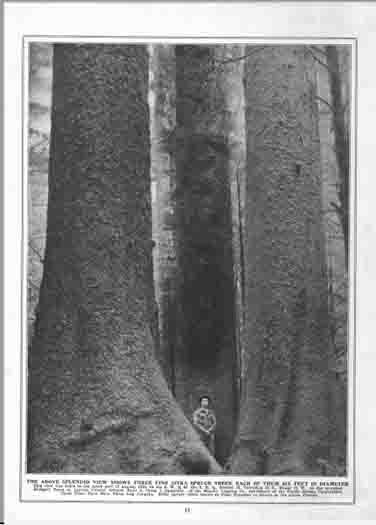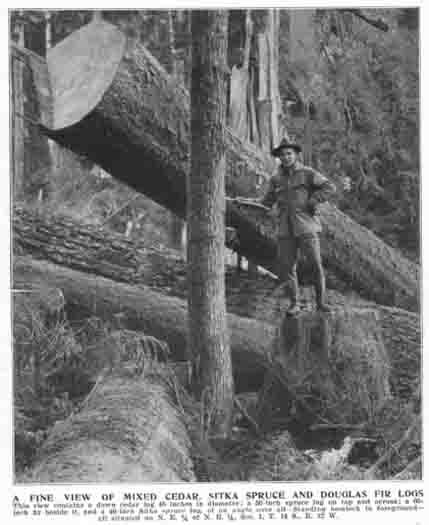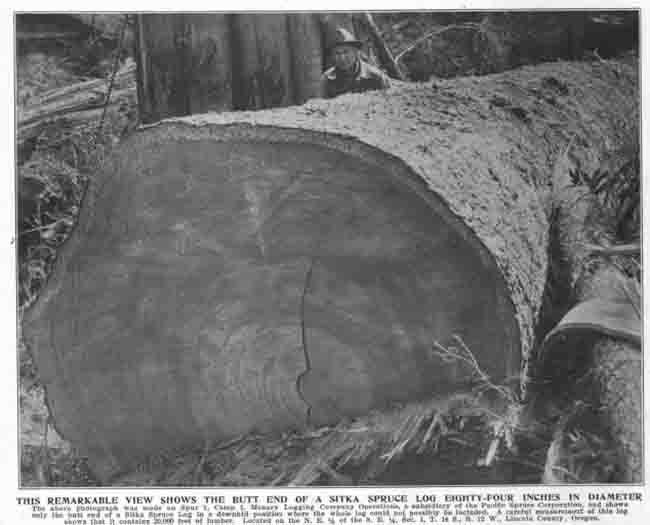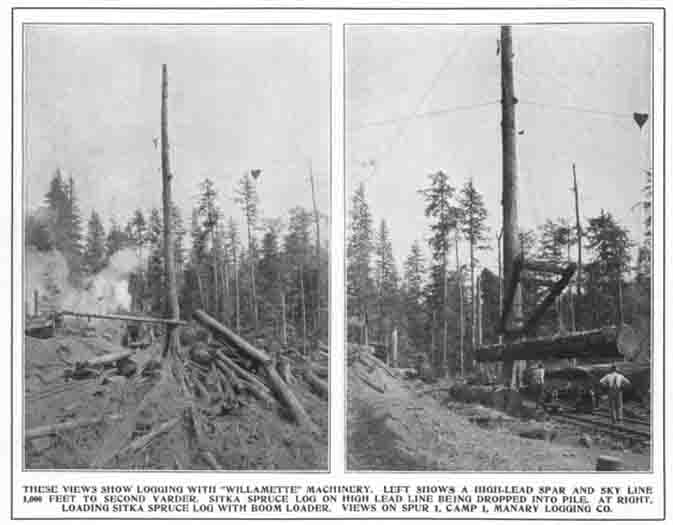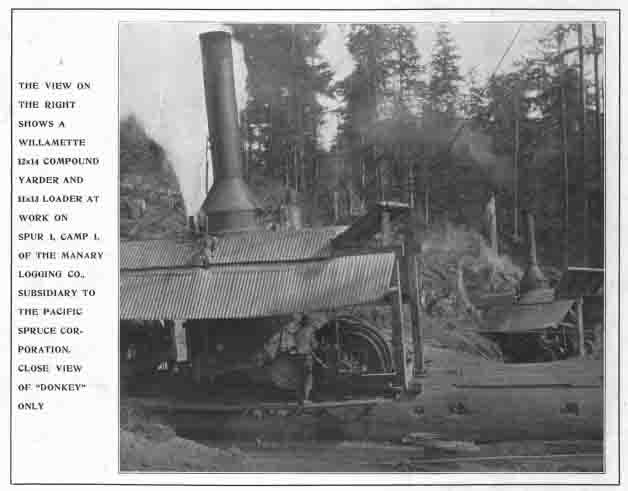Camp One Road & The Blodgett Tract
Yachats, OR 97498
World War I Logging Operations
Camp One on the Blodgett Tract was a large logging camp between 1918 and 1936.
John Blodgett purchased the eponymous tract from C.A. Smith on May 31, 1917, fifty-five days after the U.S. entered World War 1. Blodgett, an absentee investor from Michigan, knew that airplanes were going to play a role in the war. Airplanes frames at that time were made from Sitka spruce (Picea sitchensis), the lightest, strongest wood for its weight. It only grows along a narrow fog-shrouded band on the coast from northern California to Alaska. Before the war, spruce was viewed as being good for little more than making fish boxes.
Before the war, three million board feet of spruce were leaving the Northwest per month, but the government wanted ten million. Soldiers, armed with tin pants and misery whips, instead of bayonets and rifles, were brought in to do the timbering. Many had no previous experience logging. A tent camp was set up at South Beach, and men were quartered along the entire South Beach to Yachats stretch.
The early war years were also years of labor activism and radicalism in the west. The Industrial Workers of the World (I.W.W.) represented the "homeless, womanless, voteless migratory workers in the West," including loggers. They went on strike demanding better wages, improved camp conditions, and an 8 hour workday.
Col. Brice P. Disque was placed in command of the logging operations. Disque and at first said he "believed that all labor unions were infected with radical viruses." However, after visiting crowded logging camps with no bathing facilities, no provision for bedding or laundry, and inedible food he said he was dismayed that twentieth Century American workers had to live as loggers did. To undermine the threat of a strike, Disque paid the troops the same as civilian laborers, established an eight hour day, improved safety conditions, and created a surrogate union, the Loyal Legion of Loggers that included both management and labor.
To get the logs from the Blodgett Tract to a log dump in South Beach, they started building the Alsea Southern Rail Road Line in the spring of 1918. Construction was slow because timbers could only be brought in when the tides were right. Consequently, bridge timbers were rafted in.
The line was completed November 8th, three days before then end of the war. One million board feet of spruce had been bucked into logs on the Blodgett Tract, but not one had been shipped on the line.
After World War I, the Army no longer needing holdings it had in Lincoln County, put them up for sale. In 1920 C.D. Johnson, who formed the Pacific Spruce Corporation, bought the Blodgett Tract along with the railroad and a partially completed mill in Toledo. He put $50,000 down and was to pay off the rest in 10 years.
Quite a sizable camp was established at Camp one. Bunkhouses were built for single men, and small bungalows were built for those with families. The camp had a mess hall, a school, a commissary, and a machine shop built to work on locomotives and logging donkeys.
The corporation did have problems, though. For one thing, the Toledo Mill had a design capacity of 250,000 board feet per shift, making it one of the largest mills in Oregon. However, there was a decline in the fir industry. There weren't as many planes made as during the war, and those that were made had aluminum frames. Besides, the railroad trestles began to give way, and sometimes the Yaquina Bay didn't have enough water in it for the lumber schooners taking timber up to the mill.
In 1930 Pacific Spruce was behind on its payments to the government for the property and was involved in local tax disputes. It went into receivership. In 1935 it was sold by court order.
In 1936 with the timber supply exhausted, the camp and the railroad were abandoned. That fall, a fire burned 10,000 acres.
In 1941 Siuslaw National Forest bought the tract.
A few houses still exist from the logging camp days, and concrete foundations from the machine shops and engine barn can be found in the thick brush that covers the area.
Land Scam
Between 1905 and 1912, C.A. Smith, acquired the land he sold to John Blodgett in 1918 using "Dummy Entrymen." The Timber and Stone Act of 1878 allowed any citizen of Washington, Oregon, California, and Nevada to buy 160 acres of public timberland for their own personal use at $2.50 an acre. Smith and others brought trainloads of midwestern women teachers to Oregon to take up land under this Act. As soon as people had title to the land, they transferred it to Smith. Smith and his associates abused the act so systematically that some have argued that the Act had no legitimate use whatsoever.
The first "Dummy Entrymen" abused the homestead law. A person would claim a homestead site and say that they intended to develop it. Once they had the title, they would, for a small bribe of about $50, give the title to a lumberman.
Taking advantage of various government "land-lieu" Acts was another method unscrupulous sorts accumulated land. "Land-lieu" Acts allowed someone to exchange one piece of land for an equal amount of land elsewhere. Many here, including Smith, exploited the Territorial Act of 1848. The state was given sections 16 and 36 in each township to sell to fund schools. If those sections had some prior claim on them, though, such as being part of an Indian Reservation or Forest Reserve, the state could sell other pieces of land in the public domain in "lieu" of the lost school sections.
To work the scam, the lumbermen had to find two types of land. They'd scout out huge tracts of public land that had great timber on it. Next, they'd find out what land in the school indemnity sections had prior claims. Then it was simply a matter of getting a dummy buyer to buy 320 acres of lieu land at $2.50 an acre. Most of the Blodgett Tract was assembled in this manner. A grand jury report in 1905 estimated that 50% of the one million acres of school land sales then pending were fraudulent.
"Land-lieu" Acts were abused by lumbermen who would trade already cut land for virgin territory. Railroads really prospered from these Acts. To encourage the construction of railroads, particularly after the Civil War, the government offered investors alternate 640-acre sections of the public domain along rail routes. The railroads cheerfully traded off barren land for prime land in Oregon.
***
This website, yachats-history.com, is a work in progress.
I'm hoping to gather more stories about this location. If you have good ones, email me. THANKS!
